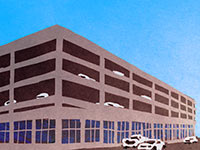COMMENT OF THE DAY: PARKING REQUIREMENTS FOR SELF-PARKING CARS  “I think the live load requirements for a parking structure are actually a little higher than a residential building, but the bigger misconception is that shared autonomous cars don’t need to park. The fleet of autonomous cars will have to be sized to meet peak demand, which happens for a few hours in the morning and a few in the afternoon. Outside of those hours, a large proportion of the fleet will need to be stored somewhere.
Overnight, that somewhere can be a non-central location, since presumably many people will still live in suburbs. But during the day, surplus vehicles will be most efficiently stored somewhere close to where their passengers will be in the afternoon.
The real advantage is that the car storage won’t have to be so closely tied to the destination, so a parking structure every few blocks should be adequate, rather than each building needing its own dedicated (usually surface) parking. It’s more likely that this garage will stay a garage, but nearby surface lots can be developed into actual buildings.” [Angostura, commenting on How To Design a Parking Garage That Won’t Become Useless Once Cars Get Restless] Illustration: Lulu
“I think the live load requirements for a parking structure are actually a little higher than a residential building, but the bigger misconception is that shared autonomous cars don’t need to park. The fleet of autonomous cars will have to be sized to meet peak demand, which happens for a few hours in the morning and a few in the afternoon. Outside of those hours, a large proportion of the fleet will need to be stored somewhere.
Overnight, that somewhere can be a non-central location, since presumably many people will still live in suburbs. But during the day, surplus vehicles will be most efficiently stored somewhere close to where their passengers will be in the afternoon.
The real advantage is that the car storage won’t have to be so closely tied to the destination, so a parking structure every few blocks should be adequate, rather than each building needing its own dedicated (usually surface) parking. It’s more likely that this garage will stay a garage, but nearby surface lots can be developed into actual buildings.” [Angostura, commenting on How To Design a Parking Garage That Won’t Become Useless Once Cars Get Restless] Illustration: Lulu





The current design for parking garages is based on allowing any vehicle in the garage to leave whenever the owner wants to go. A fleet of self driving vehicle that are all identical would not need to come and go at will. They could all be packed bumper to bumper (and door to door since no one would be getting out when they are stored) in a garage and load and unload like a ferry boat with everyone piling in one entrance and then streaming out the next. You could potentially design a garage that could store a significantly higher number of vehicles by eliminating the in and out lanes needed for regular garages. Building those on cheap land within 10-15 min of big metro center might be more cost effective than using very expensive parking in a big metro area.
I’m interested in seeing what will happen with the giant parking lots when driverless cars come about.
@OldSchool,
All depends on what the ownership model is. Uber and Lyft currently don’t really own cars, and the amount of capital needed to completely convert to a centrally-owned autonomous fleet is enormous. The business model may end up just managing individually-owned driverless cars, which would require the ability to retrieve a specific vehicle on demand.
Also, the vehicles will need to be periodically cleaned, serviced and re-fueled. But whichever form the storage takes, the big thing is decoupling the destination from the parking for that destination, allowing elimination of parking minimums and much more dense development than we have currently.